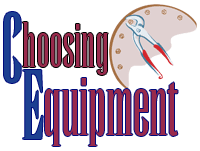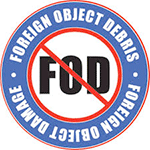Airport Sweeping

Airport Sweeping |
 |
FOD Removal: A Review of Best Management Practicesby Joe Petrie (with Ranger Kidwell-Ross)
From standard air sweepers to tow-behind to drag mats, airports utilize a variety of techniques and equipment to keep FOD (Foreign Object Damage) to an absolute minimum.
"We've seen a decrease in the total number of FOD over the last several years," he said. "We've been highlighting that to tenants as well as internally that has been a focus area on keeping an eye on that and keeping it under control." HSV has two sweeper trucks to perform regular maintenance. They also purchased a FOD Master several years ago and a Victory Sweepers T-600. These use a mechanical technique to toss debris into a hopper, which he said works better with larger pieces of FOD.
Ailing said all badge employees at HSV go through driver training in a non-movement area. This includes talking about retrieving FOD, reporting it and picking it up."We've got three ramps: an air carrier ramp, a GA ramp and a cargo ramp," he said. "So, we've rotated between each ramp and invited everybody, including our tenants, and do a FOD walk on each ramp to get an idea of what challenges each ramp has and to get out there and understand the challenges we do have with FOD." Ailing said to look at the type of FOD you're seeing at your airport along with additional restraints on the airfield before considering a sweeper device. Know your options While FOD detection systems have come on the scene in recent years, Garth Hughes, general manager of The FOD Control Corp. said airports have been slow to adopt it due to the cost and complexity. Some airports are also hesitant to spend money on a new FOD solution before there's already an issue.
While FOD detection systems have come on the scene in recent years, Garth Hughes, general manager of The FOD Control Corp. said airports have been slow to adopt it due to the cost and complexity. Some airports are also hesitant to spend money on a new FOD solution before there's already an issue.
"Until you have a large established group on which to base your purchase decisions, you're putting yourself at risk by adopting these newer technologies," he said. Hughes said finding the right sweeper depends on the size of the facility, the condition of the runways, the operating environment and the criticality of the operations. Automatic runway sweepers continue to be a popular choice for crews, he said, because they're easy to operate, however, airport administrators are less happy with the technology. "They tend to break down, they're very proprietary, so fixing them is not as easy as you might think," he said. Hughes said FOD drag mats are still very popular with airports because there's no maintenance and easy to use and understand. Some operators don't like the manual process related to cleaning out the mats after use, but Hughes said it's an incredibly effective tool compared to other cleaning technologies. "The efficacy of friction mat sweepers still can't be beaten by any of the other technologies," he said. The vacuums, the rotary brushes, nothing comes close to that, especially when it comes to small FOD." Hughes said FOD Control Corp. continues to see friction mat style sweeper in demand in critical use scenarios, such as runways. "Where there US military is operating extremely expensive aircraft like the B1 Lancer, they go to this technology versus any other one," he said. "They're trying to get 100 percent elimination of everything down to as small as possible because the cost of one FOD event is astronomical."
Giles said that in the last five years an improved operator interface with sweepers has been developed and the machines now have lower engine exhaust emissions. These improvements have allowed the sweeper to be more flexible and meet a wider array of tasks while being easier to operate, more comfortable for the operator, quieter and they use less fuel. When considering sweepers, Giles said airports need to ask if they really need a true high speed runway sweeper or if the runways can be swept during lower usage landing and takeoff periods. Airport management should also determine if they're attempting to use grant monies that require FAA high speed runway specs. "The key to effective sweeping, whether runway, tarmac or street, is proper operator training," Giles said. "While effective sweeping is not difficult, there are some key procedures that make the removal process extremely effective while preventing damage to the sweeper and maintaining operator safety.
"One of the challenges we hear about is these drag mats are wearing down the pavement surfaces," Singer said. "It removes the FOD, but they're finding that mats are also grinding down the surface." Pick what works for you
By running their sweepers side-by-side and utilizing good time management skills, Mason said they're able to clear the entire runway in that short period of time. "They keep getting more efficient," he said. They've got big hoppers and strong suction, so we can clear a runway in a few passes and they can travel at a pretty good speed, so they're pretty much the best equipment out there." Mason said San Diego has a lot of finer debris left over from ongoing construction projects that crews work on. Contractors do their own cleanup, but he said the airport makes a conscious effort to increase its efforts as well to ensure clean airfields. "We're located pretty close to San Diego Bay as well," Mason said. "So in the event we have any rain, which is pretty rare, a lot of the debris that we sweep up can flow into the storm drains and into the bay, so we increase our sweeping operations around that time just to make sure nothing is going into the storm drains. Our sweepers will pick up all of that.
"We're seeing larger aircraft, which was kind of a concern with our runway, which was constructed in the 1940s," Maxwell said. "We started seeing some cracking and some damage. When I took over in April, there was a significant amount of FOD." Maxwell said she initially did visual checks of the 7,200 feet long runway for FOD, but the process was timely and inefficient. She then used a street sweeper from the city's public work's department to address the problem, but that also created issues. "They have metal bristles and actually it made more of a mess because it left metal bristles on the runway," she said. "They looked like dipsticks for checking oil." Maxwell said a colleague at another airport recommended other sweepers and she eventually went with the FOD Boss, which she pulls behind a Ford Ranger. "Along with doing some repairs to the runway, the FOD has decreased," she said. "The runways and taxiways are all significantly cleaner now than before I got here." Maxwell said other airports with access to public works equipment need to consider what type of materials are being used before implementing them on the airfield. They can create more issues than helping in FOD removal. She also recommended researching the equipment to make sure there are multiple manufacturers of the tools to make sure you're investing in the best product for your needs. Do backgrounds and reviews of the equipment on the market and also try to get a demo piece to test out before making an investment. "I'm not the only one at an airport who doesn't have a type of sweeper or street sweeper. They're doing it the way I do it, which is driving up and down and trying to collect FOD," she said. FOD issues currently cost the aerospace industry an estimated $4 billion per year. One of the better explanations about FOD and the problems it can cause may be found on the Boeing Company website here.
|